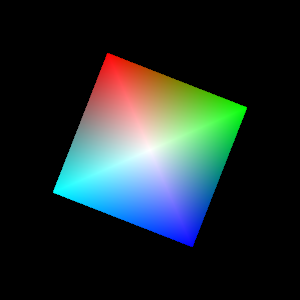glitter Example: Simple
Summary
This program will open a GLUT window and render a colored, rotating quad.

Front matter
Module docstring
The module docstring is used as a description of this example in the generated documentation:
"""Simple example displaying a rotating quad.
@author: Stephan Wenger
@date: 2012-02-29
"""
Imports
Our scene is going to rotate. The rotating modelview matrix is computed using the sine and cosine functions from the math module:
from math import cos, sin
We can usually import classes and functions contained in glitter submodules directly from glitter:
from glitter import VertexArray, get_default_program
Modules with external dependencies other than numpy, such as platform dependent parts like methods for the generation of an OpenGL context, however, have to be imported from their respective submodules:
from glitter.contexts.glut import GlutWindow, main_loop, get_elapsed_time
Vertex arrays
The geometry is specified as arrays (or nested lists) of vertices, colors, and indices into the vertex and color arrays. Lists are automatically converted to appropriate numpy arrays. The shape of these arrays describes how the arrays are to be drawn. When an index array is used, as in this example, the vertex and color arrays are two-dimensional: the first dimension is the number of vertices, the second is the number of values for each vertex (e.g. the red, green, blue, and alpha channels for a color array). The shape of the index array is also two-dimensional: the first dimension is the number of primitives to be drawn, the second is the number of vertices in each primitive. Here, we draw four triangles forming a quad.
vertices = ((0, 0, 0), (-1, 1, 0), (1, 1, 0), (1, -1, 0), (-1, -1, 0))
colors = ((1, 1, 1), (0, 1, 0), (0, 0, 1), (0, 1, 1), (1, 0, 0))
indices = ((0, 1, 2), (0, 2, 3), (0, 3, 4), (0, 4, 1))
Main class
We wrap all the OpenGL interaction in a class. The class will contain an
__init__() method to set up all OpenGL objects, any required
callback methods, as well as a run() method to trigger execution
of the GLUT main loop.
class SimpleExample(object):
Initialization
When a SimpleExample instance is created, we need to
initialize a few OpenGL objects.
def __init__(self):
First, we create a window; this also creates an OpenGL context.
self.window = GlutWindow(double=True, multisample=True)
Then, we set the GLUT display callback function which will be defined later.
self.window.display_callback = self.display
In the OpenGL core profile, there is no such thing as a "standard pipeline"
any more. We use the minimalistic defaultpipeline from the
glitter.convenience module to create a shader program instead:
self.shader = get_default_program()
Here, we create a vertex array that contains buffers for two vertex array input variables as well as an index array:
self.vao = VertexArray(vertices, colors, elements=indices)
Callback functions
Display function
Here we define the display function. It will be called by GLUT whenever the screen has to be redrawn.
def display(self):
First we clear the default framebuffer:
self.window.clear()
To draw the vertex array, we use:
self.vao.draw()
After all rendering commands have been issued, we swap the back buffer to the front, making the rendered image visible all at once:
self.window.swap_buffers()
Timer function
The animation is controlled by a GLUT timer. The timer callback changes the modelview matrix, schedules the next timer event, and causes a screen redraw:
def timer(self):
We first get the elapsed time from GLUT using get_elapsed_time():
phi = get_elapsed_time()
We then set the modelview_matrix uniform variable of the
shader created in the initialization section simply by setting an
attribute:
self.shader.modelview_matrix = ((cos(phi), sin(phi), 0, 0), (-sin(phi), cos(phi), 0, 0), (0, 0, 1, 0), (0, 0, 0, 2))
The following line schedules the next timer event to execute after ten milliseconds.
self.window.add_timer(10, self.timer)
Finally, we tell GLUT to redraw the screen.
self.window.post_redisplay()
Running
We will call the run() method later to run the OpenGL code.
def run(self):
To start the animation, we call the timer once; all subsequent timer calls will be scheduled by the timer function itself.
self.timer()
The default program is bound by using a with statement:
with self.shader:
With the shader bound, we enter the GLUT main loop.
main_loop()
When the main loop exits, control is handed back to the script.
Main section
Finally, if this program is being run from the command line, we instanciate the main class and run it.
if __name__ == "__main__":
SimpleExample().run()